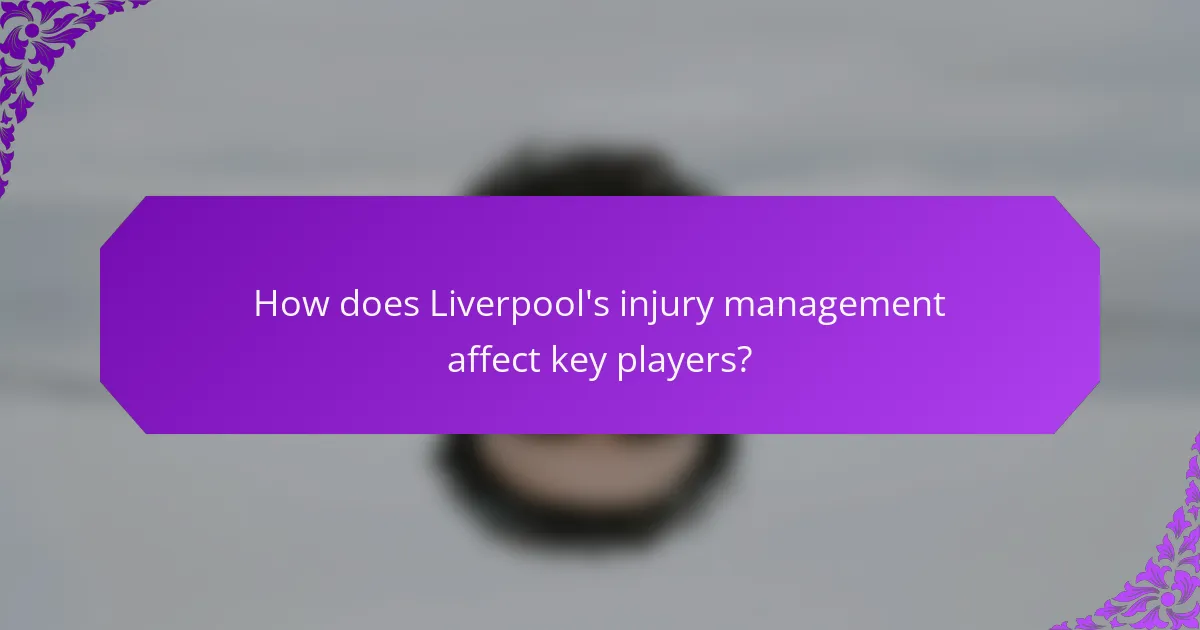Liverpool’s Injury Management focuses on a systematic approach to evaluating, treating, and rehabilitating player injuries, led by a specialized medical team comprising doctors, physiotherapists, and sports scientists. The club employs advanced diagnostic tools and tailored recovery protocols to address individual player needs, emphasizing both physical rehabilitation and psychological support. This comprehensive strategy aims to minimize recovery time, reduce the risk of re-injury, and enhance overall team performance. Data indicates that effective injury management correlates with fewer recurring injuries among key players, ultimately contributing to improved on-field performance and fitness monitoring. Structured injury management processes, including immediate assessment and rehabilitation programs, are critical for ensuring players return to peak condition.

What is Liverpool’s Injury Management?
Liverpool’s Injury Management involves a comprehensive approach to assessing, treating, and rehabilitating player injuries. The club employs a specialized medical team that includes doctors, physiotherapists, and sports scientists. This team uses advanced diagnostic tools to evaluate injuries accurately. Recovery protocols are tailored to each player’s specific needs. Emphasis is placed on both physical rehabilitation and psychological support. Liverpool’s methods aim to minimize recovery time and prevent future injuries. The club’s approach has been linked to improved player performance on the field. Data from the past seasons shows a decrease in recurring injuries among key players.
How does injury management influence team performance?
Injury management significantly influences team performance by ensuring player availability and optimizing recovery. Effective injury management reduces the duration of player absences due to injuries. It allows teams to maintain a stable lineup, which is crucial for team cohesion and strategy execution. Studies show that teams with better injury management protocols tend to perform better in competitions. For example, a review of Premier League teams indicated that those with advanced medical staff had fewer player injuries and improved overall performance metrics. Additionally, timely rehabilitation can enhance player fitness levels, contributing to stronger team dynamics on the field.
What are the key factors in assessing player injuries?
Key factors in assessing player injuries include the type of injury, severity, and player history. The type of injury indicates whether it is acute or chronic. Severity is classified on a scale, often from mild to severe. Player history provides context on previous injuries and recovery times. Physical examinations assess range of motion and pain levels. Diagnostic imaging, such as MRI or X-rays, confirms the diagnosis. Timely assessment is crucial for effective recovery planning. Accurate assessment reduces the risk of re-injury during return to play.
How do injuries impact match outcomes for Liverpool?
Injuries significantly impact match outcomes for Liverpool. Key players missing due to injury can weaken the team’s overall performance. For instance, during the 2020-2021 season, Liverpool faced a series of injuries that resulted in a drop in form. The absence of central defenders led to defensive instability, contributing to a loss of points in crucial matches. Statistics show that Liverpool’s win percentage decreased when key players were sidelined. Injuries can also disrupt team chemistry and tactics, making it harder to maintain consistent performance. Overall, injuries create a ripple effect that can adversely affect Liverpool’s chances in matches.
What recovery protocols are implemented by Liverpool?
Liverpool implements various recovery protocols to enhance player rehabilitation. These protocols include physiotherapy sessions tailored to individual needs. They utilize advanced technology such as cryotherapy and hydrotherapy for effective recovery. Nutrition plays a crucial role, with personalized meal plans provided to players. Mental health support is also integrated into their recovery strategy to ensure overall well-being. Regular assessments track player progress and adapt recovery plans accordingly. These measures aim to reduce injury recurrence and improve performance on the field.
What types of rehabilitation techniques are used?
Rehabilitation techniques used in sports injury management include physical therapy, strength training, and functional rehabilitation. Physical therapy focuses on restoring movement and reducing pain through exercises and modalities. Strength training helps rebuild muscle strength and endurance after injury. Functional rehabilitation emphasizes sport-specific movements to prepare athletes for return to play. These techniques are critical for effective recovery and minimizing the risk of re-injury. Studies show that a structured rehabilitation program can significantly improve recovery times and overall performance.
How does nutrition play a role in recovery?
Nutrition significantly aids recovery by providing essential nutrients needed for healing. Proper nutrition supports muscle repair, reduces inflammation, and replenishes energy stores. Protein intake is crucial for muscle recovery, as it provides amino acids necessary for tissue repair. Carbohydrates are vital for restoring glycogen levels depleted during physical activity. Hydration plays a key role in recovery as well, ensuring optimal physiological function. Micronutrients, such as vitamins and minerals, contribute to immune function and overall health. Studies indicate that athletes who prioritize nutrition experience faster recovery times. For example, research published in the Journal of Sports Sciences highlights the correlation between nutrient timing and recovery efficiency.
What are the challenges faced in injury management?
Challenges in injury management include accurate diagnosis, effective rehabilitation, and timely return to play. Misdiagnosis can lead to improper treatment and prolonged recovery. Rehabilitation programs must be tailored to individual needs, which can complicate recovery. Additionally, psychological factors such as fear of re-injury can hinder an athlete’s progress. Monitoring player workload is crucial to prevent further injuries. Communication between medical staff, coaching staff, and players is often lacking, affecting management strategies. Lastly, the pressure to perform can lead to rushed recovery, increasing the risk of setbacks. These challenges are critical in maintaining team performance and player health.
How does player workload affect injury rates?
Player workload significantly affects injury rates. Higher workloads can lead to increased fatigue and stress on the body. This stress can result in a greater likelihood of musculoskeletal injuries. A study published in the British Journal of Sports Medicine found that players with increased training loads had a higher incidence of injuries. Specifically, the study indicated that a 10% increase in workload correlated with a 15% rise in injury risk. Monitoring player workload is essential for effective injury prevention strategies. Teams that manage workloads effectively can reduce injury rates and enhance overall performance.
What role does medical staff play in managing injuries?
Medical staff play a crucial role in managing injuries. They assess the severity of injuries and determine appropriate treatment plans. Medical staff provide immediate care during matches and training sessions. They also monitor player recovery and rehabilitation processes. Their expertise helps prevent further injuries through tailored training programs. Communication with coaching staff is essential for optimal player health. Evidence shows that effective injury management can enhance team performance. Studies indicate that teams with strong medical support experience fewer long-term injuries.

How does Liverpool’s injury management affect key players?
Liverpool’s injury management significantly impacts key players’ performance and availability. The club employs advanced medical protocols to monitor player fitness. This includes regular assessments and tailored rehabilitation programs. Effective injury management reduces the risk of re-injury. It also ensures that players return to peak condition. For instance, Liverpool’s use of sports science has improved recovery times. Studies show that clubs with robust injury management see fewer long-term injuries. Consequently, this leads to better overall team performance.
Which players have been most affected by injuries?
Virgil van Dijk and Joe Gomez have been most affected by injuries in Liverpool. Virgil van Dijk suffered a significant knee injury in October 2020. This injury sidelined him for several months, impacting Liverpool’s defensive capabilities. Joe Gomez also faced a serious knee injury during international duty in November 2020. His absence further weakened Liverpool’s defensive line. Both players are crucial to Liverpool’s success. Their injuries led to a notable decline in the team’s performance during the 2020-2021 season.
What are the long-term impacts of injuries on player careers?
Long-term impacts of injuries on player careers include reduced performance, increased risk of re-injury, and shortened career spans. Players often experience chronic pain or mobility issues following significant injuries. This can hinder their ability to perform at peak levels. Statistics show that athletes with previous injuries are 50% more likely to sustain future injuries. Additionally, psychological effects such as anxiety about re-injury can affect performance. Players may also face difficulties in transitioning to post-playing careers due to prolonged recovery times. These factors collectively influence a player’s longevity and effectiveness in their sport.
How do injuries influence player selection and tactics?
Injuries significantly influence player selection and tactics in football. When key players are injured, coaches must adjust their lineups. This often leads to the inclusion of less experienced players. Tactical formations may also change to accommodate available players. For example, a coach might shift from a 4-3-3 to a 4-2-3-1 formation. This adjustment can help maintain team balance despite missing players. Historical data shows that teams with multiple injuries often struggle to maintain performance levels. For instance, Liverpool faced challenges during the 2020-2021 season when several key players were sidelined. These changes impact overall team dynamics and strategy.
What strategies does Liverpool use to minimize injuries?
Liverpool employs several strategies to minimize injuries among players. These include advanced sports science and data analytics. The club utilizes technology to monitor player loads during training sessions. This helps in identifying potential fatigue and overuse injuries. Liverpool also emphasizes individualized training programs tailored to each player’s needs. They incorporate regular physiotherapy and recovery sessions into the training schedule. Additionally, the club focuses on nutrition and hydration to support player health. These strategies collectively aim to enhance player performance and reduce injury rates.
How does training intensity relate to injury prevention?
Training intensity significantly impacts injury prevention. Higher training intensity can lead to increased fatigue and a higher risk of injury. Conversely, appropriate training intensity allows for better adaptation and conditioning. Research shows that athletes who train at optimal intensity levels experience fewer injuries. A study by Gabbett (2016) found that training loads, when managed effectively, reduce injury rates in rugby players. Monitoring training intensity helps in identifying overtraining signs, which is crucial for injury prevention. Therefore, balancing training intensity is essential for maintaining athlete health and performance.
What role does technology play in monitoring player health?
Technology plays a crucial role in monitoring player health. It enables real-time tracking of physiological metrics. Wearable devices collect data on heart rate, movement, and fatigue levels. This information helps coaches and medical staff make informed decisions. Advanced analytics tools process data to identify potential injury risks. For example, GPS tracking can reveal overexertion during training sessions. Studies show that teams utilizing such technology reduce injury rates significantly. The integration of technology enhances recovery protocols by tailoring rehabilitation programs. Overall, technology is essential for optimizing player health and performance.

What are the best practices for effective injury management?
Effective injury management involves immediate assessment, appropriate treatment, and structured rehabilitation. First, assess the injury to determine its severity. Use the RICE method: Rest, Ice, Compression, and Elevation for initial treatment. This method helps reduce swelling and pain. Next, consult a medical professional for a comprehensive evaluation. Follow their guidance on treatment options, which may include physical therapy or medication. Implement a tailored rehabilitation program to restore strength and flexibility. Gradually reintroduce activity to prevent re-injury. Regular monitoring of recovery progress is essential for adjusting protocols. Studies show that structured injury management significantly reduces recovery time and improves overall team performance.
How can teams improve their injury management protocols?
Teams can improve their injury management protocols by implementing comprehensive assessment procedures. Regular screenings can identify potential injury risks early. Utilizing data analytics helps track player health and performance metrics. Establishing clear communication between medical staff and coaching personnel enhances decision-making. Training staff in the latest rehabilitation techniques ensures effective recovery plans. Incorporating psychological support aids in mental recovery alongside physical healing. Collaborating with sports scientists can optimize training loads to prevent injuries. Evidence shows that teams adopting these strategies experience fewer injuries and quicker recovery times, leading to improved overall performance.
What lessons can be learned from Liverpool’s approach?
Liverpool’s approach to injury management emphasizes proactive prevention and tailored recovery protocols. The club invests in advanced sports science and data analytics to monitor player fitness. This strategy allows for early identification of potential injuries. Liverpool’s medical team collaborates closely with coaching staff to ensure optimal player readiness. The implementation of individualized recovery plans enhances player performance post-injury. Historical data shows that this approach has led to fewer long-term injuries. Consequently, Liverpool maintains a competitive edge in high-stakes matches. The club’s focus on holistic player welfare fosters a resilient team environment.
What tips can players follow to aid their recovery?
Players can follow several tips to aid their recovery. First, prioritize rest to allow the body to heal. Adequate sleep is essential for muscle recovery and overall health. Hydration plays a crucial role in recovery; players should drink plenty of fluids. Nutrition is equally important; a balanced diet supports healing and energy replenishment. Incorporating stretching and mobility exercises can enhance flexibility and reduce stiffness. Players should also engage in low-impact activities, such as swimming or cycling, to maintain fitness without straining injured areas. Regular physiotherapy sessions can provide targeted treatment and guidance for recovery. Finally, mental health support can aid in coping with the psychological aspects of injury recovery.
Liverpool’s Injury Management focuses on a comprehensive approach to assessing, treating, and rehabilitating player injuries, employing a specialized medical team that utilizes advanced diagnostic tools and tailored recovery protocols. The article explores how effective injury management influences team performance, highlighting the impact of injuries on match outcomes and player selection. It details the key factors in assessing injuries, the rehabilitation techniques used, and the role of nutrition in recovery. Additionally, the piece addresses the challenges faced in injury management and the strategies Liverpool employs to minimize injuries, ultimately emphasizing the importance of proactive measures for maintaining player health and optimizing team performance.
